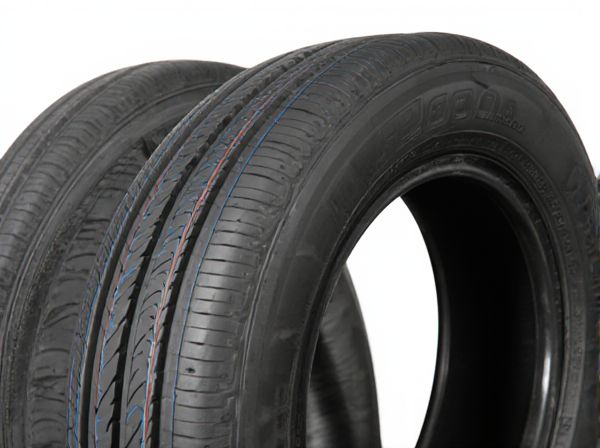
Photo illustration: Tubeless vs Tube-Type
You can enhance your cycling experience by choosing between tubeless and tube-type tires, each offering unique benefits. Tubeless tires provide lower rolling resistance and better puncture protection, improving performance and comfort on varied terrains. Tube-type tires remain a reliable and cost-effective option, especially for easy repairs and compatibility with most wheels.
Table of Comparison
| Feature | Tubeless Tire | Tube-Type Tire |
|---|---|---|
| Air Retention | Better seal, less air loss | Higher air leakage risk |
| Puncture Repair | Easier with plugs, no tube removal | Requires tube patch or replacement |
| Weight | Lighter due to absence of tube | Heavier from additional tube |
| Ride Comfort | Smoother, better shock absorption | Less flexible, rougher ride |
| Safety | Slower air loss reduces sudden flats | Rapid deflation risk during punctures |
| Cost | Generally higher initial cost | Lower purchase price |
| Maintenance | Less frequent, simpler repair | More frequent tube checks needed |
| Compatibility | Requires compatible rims | Works with most standard rims |
Introduction to Tubeless and Tube-Type Tires
Tubeless tires feature an airtight seal between the tire and rim, eliminating the need for an inner tube and reducing the risk of sudden flats. Tube-type tires contain a separate inner tube that holds the air, which can be more susceptible to punctures and requires more maintenance. Both systems offer distinct advantages for different riding conditions, with tubeless tires providing improved performance and tubetype offering simpler repairs.
Key Differences Between Tubeless and Tube-Type Tires
Tubeless tires eliminate the inner tube, creating an airtight seal between the tire and rim, reducing the risk of punctures and allowing lower tire pressure for improved traction. Tube-type tires rely on an inner tube to hold air, which can be more prone to pinch flats but often easier to repair quickly. Tubeless systems generally offer better fuel efficiency and enhanced ride comfort due to reduced weight and improved heat dissipation.
Advantages of Tubeless Tires
Tubeless tires offer improved puncture resistance due to their airtight seal, reducing the risk of sudden air loss and enabling slow leaks that allow riders to continue with minimal disruption. They enhance performance by lowering rolling resistance and providing better heat dissipation, which contributes to increased fuel efficiency and longer tire life. Maintenance is simplified as tubeless tires eliminate the need for inner tubes, reducing weight and the chance of pinch flats, making them a popular choice for both cyclists and motorists seeking reliability and durability.
Benefits of Tube-Type Tires
Tube-type tires offer enhanced protection against sudden air loss due to the inner tube acting as a secondary barrier, making them reliable for off-road and rugged terrain use. They are often easier to repair in the field, as punctures can be quickly patched without specialized tools or equipment required by tubeless systems. Additionally, tube-type tires tend to be more cost-effective and compatible with a wider range of wheel designs, benefiting riders with budget constraints or older bike models.
Drawbacks of Tubeless Tires
Tubeless tires can be more difficult to mount and repair compared to tube-type tires, often requiring specialized tools and sealant for proper installation and maintenance. They may also experience slow air leakage due to punctures that are not immediately sealed, leading to potential performance issues over time. Compatibility issues with certain rim designs can limit their use, making tube-type tires a more versatile choice for some riders.
Disadvantages of Tube-Type Tires
Tube-type tires often experience higher risks of sudden air loss due to punctures or pinch flats, leading to potential safety hazards. They require more frequent maintenance and can be heavier than tubeless counterparts, impacting overall vehicle efficiency. The inner tube also generates additional friction and heat, reducing tire durability and performance.
Performance Comparison: Tubeless vs Tube-Type
Tubeless tires offer superior performance by reducing the risk of sudden flats and allowing lower tire pressure for enhanced traction and comfort, making them ideal for high-speed and off-road conditions. Tube-type tires, while often more affordable and easier to repair, can experience rapid air loss from punctures and increased rolling resistance compared to tubeless setups. The improved air retention and puncture resistance of tubeless tires contribute to better overall efficiency and handling in both on-road and off-road cycling or driving scenarios.
Safety Considerations for Both Tire Types
Tubeless tires reduce the risk of sudden air loss due to their airtight seal between the tire and rim, enhancing safety during punctures by allowing slower deflation rates. Tube-type tires are more prone to rapid blowouts from pinch flats or valve failures, posing higher risks in high-speed conditions. Proper maintenance and correct tire pressure are critical for safety in both tubeless and tube-type systems.
Maintenance and Repair: Tubeless vs Tube-Type
Tubeless tires require less frequent maintenance since they are less prone to punctures and can self-seal small holes, reducing downtime and repair costs. Tube-type tires, on the other hand, often require removal and replacement of the inner tube when punctured, increasing maintenance time and complexity. Repairing tubeless tires typically involves simple plug kits, while tube-type repairs demand more tools and expertise, impacting overall maintenance efficiency.
Which Tire Type is Best for You?
Choosing between tubeless and tube-type tires depends on your riding preferences and terrain. Tubeless tires offer better puncture resistance, lower rolling resistance, and improved traction, making them ideal for off-road and performance cyclists. Tube-type tires are easier to repair and often more affordable, suitable for casual riders or those prioritizing convenience.
 caratoz.com
caratoz.com